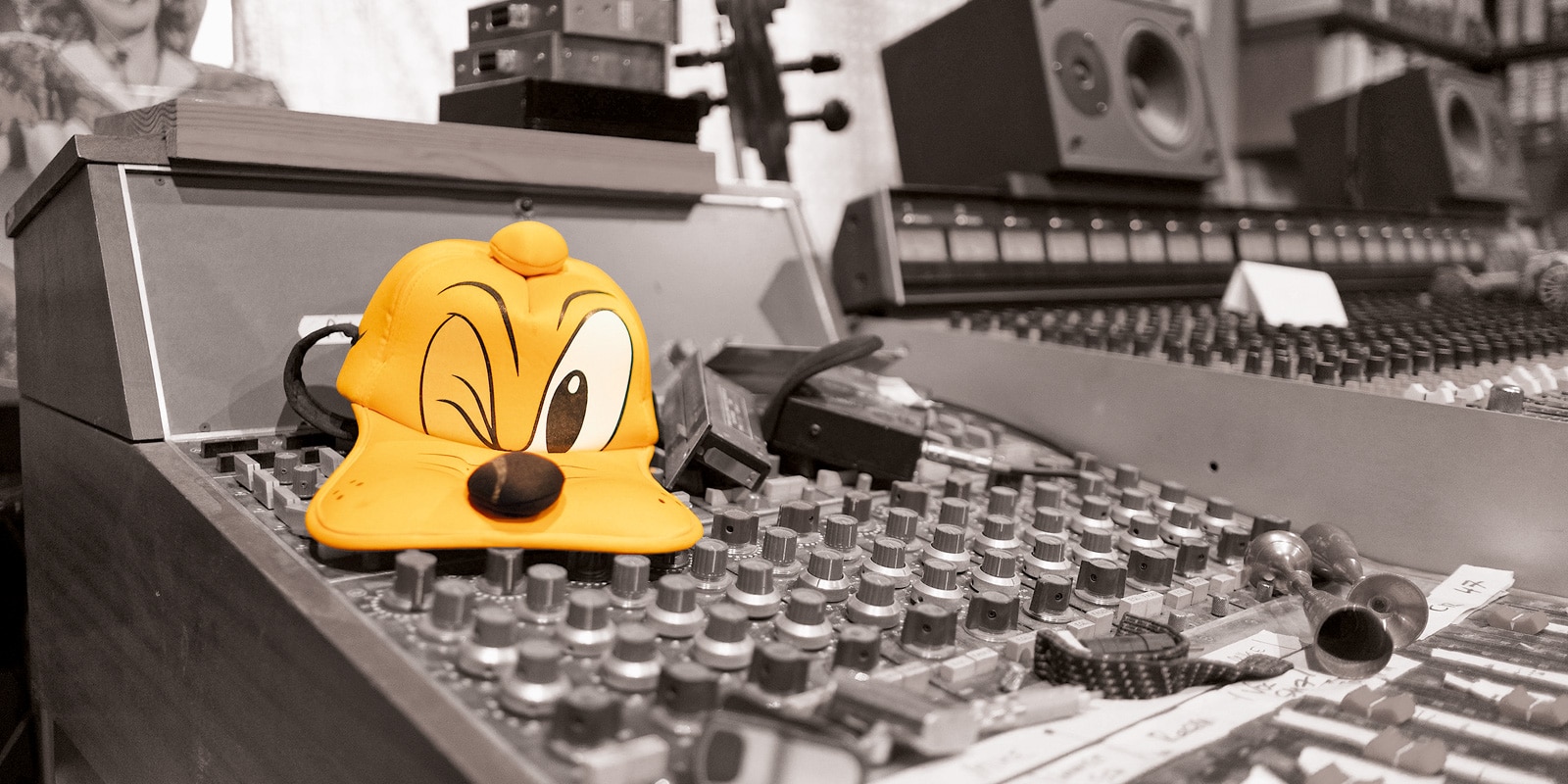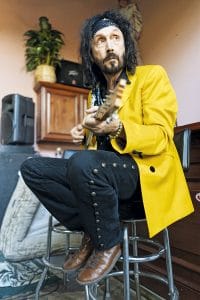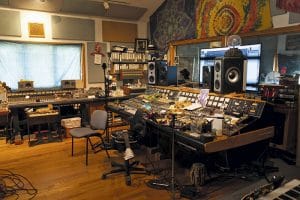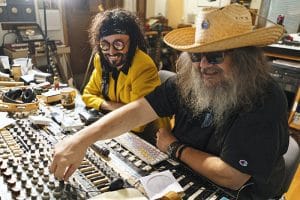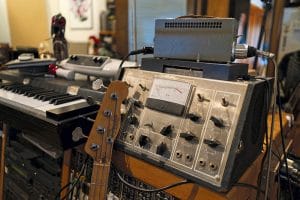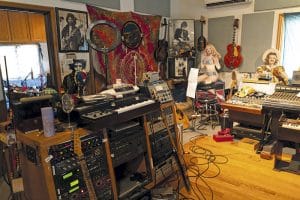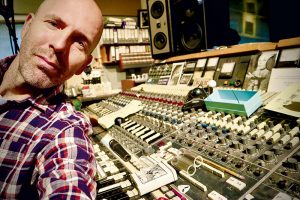Dirty Knobs, Scratchy Pots, and Dance Party Boogie-Woogie
By Paul Vnuk Jr.
Wreckless Abandon is the Dirty Knobs’ debut recording. Formed over a decade ago, the Dirty Knobs began as a side project by Tom Petty and the Heartbreakers lead guitarist and co-songwriter, Mike Campbell. The band includes guitarist Jason Sinay (Neil Diamond, Jerry Lee Lewis, Jackson Browne, Lucinda Williams), bassist Lance Morrison (Don Henley, Volto!) and drummer Matt Laug (Alanis Morissette, Alice Cooper, Slash’s Snakepit). It was produced by George Drakoulias (The Black Crowes, The Jayhawks, Tom Petty and the Heartbreakers, Tift Merritt) and mixed by engineer Martin Pradler (Ry Cooder, Robbie Robertson; see our March 2020 interview). There are also guest appearances by Chris Stapleton, Benmont Tench and Augie Meyers. It’s a thick, layered straight-ahead rocker, with pristine production values and depth. Kick back and get your boogie on as Mike, George, and Martin take us behind the scenes into the making of Wreckless Abandon.
On Mixing
- The Dirty Knobs — Recording Wreckless Abandon
- Remixing John Lennon
- Vance Powell On Mixing The Raconteurs’ Help Us Stranger
- Steinberg Cubase Power Tips With Sound Designer Robert Dudzic
- On Mixing
- The Art Of Cooking Up A Good Mix!
- Tracking and Mixing for Solid Lows
- Observations On Mixing
- 10 Tips for Better Low End
- Multiband Dynamics
Mike Campbell
How did the band and the new album come about?
The Dirty Knobs is a band that I’ve had for about 15 years, that I would play with in between Heartbreakers tours. We started out just for a little bit for fun, and we enjoyed it so much, we just kept playing. It was a great workshop for me. I always figured if the Heartbreakers ever took a hiatus, this is something I’d really want to do. Now it’s my main focus.
As a songwriter, are you someone who compartmentalizes—this is a Heartbreaker’s song, this is a Stevie Nicks song, this is a Don Henley song, I’m going to keep this one for myself?
I don’t write with a specific person or goal in mind other than just writing a really good song that I like. Over the years with Tom, I would write a lot of music mostly, and then I would give him my demos, and if I was lucky, he would write words to them, and we would turn them into a record. The Don Henley song [‘The Boys of Summer’] is something I wrote for myself; Tom passed on it, so I gave it to Don. For the last several years with the Dirty Knobs, I’ve become more interested in writing the lyrics as well as the music.
What is your typical writing process? Do you demo songs in your studio or just pull out your iPhone to get an idea down?
I consider writing a very spiritual thing, and I write every day, whether I have time for it or not. I have a home studio where we recorded the Dirty Knobs record and some of the Heartbreakers songs over the years. If I get an idea, the iPhone is great to put a sketch down real quick with guitar and voice or whatever. Then if it becomes something good, I’ll step across the room to the studio and make a track.
I watched your ‘Lockdown’ video [youtu.be/um2HLwseRaI] and I’m assuming that’s your studio?
Yeah.
I love the vintage Neve console, but I also noticed on the screen, you had the Waves J37 Tape plugin running, and what I found the most curious is that you were singing into an old RCA 77DX ribbon mic and a Shure SM7B. Why both?
Usually, I would just sing into one mic. We used the SM7 on the record. Then a friend of mine found the RCA 77 for sale, and I set both mics up at the same time, side by side in the control room, and I just liked that sound. It’s a little fuller.
In the video, I also love that I could see the microwave and the kitchen where you were tracking guitars.
Ha! Adjacent to my control room, I have a lounge with an upright piano, and there’s a little kitchenette for guys to partake if they need to.
Do you remember the first time you went into a studio and heard your sounds coming back through the monitors?
I do. We were in Gainesville, and we had cut a demo of a song Tom and I wrote called ‘Tough Row to Hoe’. I think it cost us $800 to go down to Criteria in Miami to record a single. Aside from demos done with a mobile rig, we’d never been in a proper recording studio before. I quickly realized that what it sounds like standing in the room by the amp is not always what it sounds like coming back through the microphones.
I had a Fender Twin Reverb at the time, which I would never play now because they’re so frigging bright and loud. We set up in the studio, and one of the Albert brothers [the primary engineers at Criteria] came over to my amp, and I said, it’s so loud, I can’t get any growl out of it. He pulled one of the power tubes right out of the back of the amp. I thought it would just shut off. He said, “No, it’ll still play. The other tube will just work harder and get more grunge into your sound.” That’s when I began to realize that there was a whole other art to getting your sound in a studio than just setting up how you would in rehearsal.
Did you get involved in the engineering side?
The Heartbreaker’s first album was produced by Denny Cordell, and it was done in an office building converted to a studio. Denny was always open to creative input from day one, and we trusted him. So, from the beginning, we were involved, but we didn’t really know anything. We’d have to ask questions, but as time went on, I would always watch the engineers, see what they were doing, and I began to learn. I’m not a technical engineer, but I know how to get a sound—where to put the mic, how to set the amp up, how to get a level. I couldn’t fix the console if it broke…
How long have you had your home studio?
I’ve always had studios at my house. By the second album [You’re Gonna Get It!], I had a Teac four-track. When I moved into a slightly bigger house, I got a Soundcraft 16-channel board that we did Full Moon Fever on, and I got an Otari 24-track analog machine. It’s grown with better equipment and more microphones. Now I have a studio wing beside the house, so I have more isolation and privacy. I’ve gone past analog tape because it’s just so cumbersome. Pro Tools has gotten really good, especially if you use it like a tape recorder, which is what I do. I have an old Neve that I use for inputs, which you saw in the video. I still have the Soundcraft that I use for extra inputs, then I put everything into a Pro Tools session and mix in there.
And you have a house engineer?
I have this guy who worked on the Dirty Knobs album, Martin Pradler. He’s actually coming by today. He went and got an oven to bake my old analog tapes in so that we can listen to them. He does a lot of work with Ry Cooder, and he’s got a great ear. Between him doing all the technical work and setup and George producing, that was how we recorded Wreckless Abandon.
I interviewed Martin back in March when he mixed Robbie Robertson’s Sinematic. I was really inspired by his mixing techniques and creativity.
That’s cool! Yeah, Martin is amazing. And he’s just up the street. If I have a problem, he’ll pop over and help me out.
How did you choose George Drakoulias to produce the album, and what should someone look for in a producer?
I would recommend that you find a producer that’s not only talented, but trustworthy. You need to trust that, if you bring in a song, they will help you realize the song the way you hear it in your head and not take it off on some tangent. Once you gain trust, then you can move forward.
I wanted somebody to help me pick the songs and help decide if it’s a good take or a good vocal or solo. When there’s a producer there, you try a little harder to impress them. They become your audience. They can push you when you need to be pushed, hold your hand when you need to have your hand held, and lead you down a path to a result that’s better than you could have done on your own. A producer is also the guy that makes everybody feel comfortable, and George is very lighthearted and makes it fun. We could have done it without George. The sounds were already kind of there—the drum sound is set up, the guitars are set up. We can just walk in and turn everything on, and it sounds good. We don’t have to dick around getting things miked and this and that. So that saves a lot of time. But I wanted the band to all play at once live on the floor. I wanted high production values, and I didn’t want to do piecemeal tracking. I wanted the glue and excitement of four guys having fun together. It’s nice to have a guy there to let you know when to do it again, then say, “You got it, move on to the next song.” George was great like that.
George Drakoulias
How did you get involved with Wreckless Abandon?
I worked with Tom and the Heartbreakers on a few things previously, and I’ve known Mike for over 25 years. In January 2018, we sat down and talked about the album, and he played me some really good songs. They are a real boogie band, like a dance party boogie band, a barn burner. Everybody’s having a good time, a lot of double entendre lyrics and the songs are well crafted, and the playing is tight—take no prisoners and lock the place down.
So, we started recording, very casually at Mike’s place, which is one of my favorite places to work. We did a few tracks. Then he told me that he was going on tour with Fleetwood Mac for a while. He sang a few songs with them in the show, and when we came back to record, he was really vocally
on it. I always thought he was one of the best guitar players in the world, but I really feel like his singing kind of came to light over the last two years.
At some level, this album will be compared to the Heartbreakers, and vocally, there is a Tom Petty vibe, but then you realize it’s because you have heard Mike’s voice on all those classic records.
He’s been singing and standing next to Tom for 40 years on stage. Of course he’s going to have some of that influence, for sure.
What does it mean to be a producer today, and what is different from your early production work?
I think it’s flexible—it’s different things for different people. Some people just need cheerleaders. Some people just need you to agree with them. Some people need you to hold their hand. In the R&B and hip-hop worlds, people need you to come in with tracks. Most important is to have a good time—if it’s made with love and joy, it’ll come out that way.
Are you a hands-on producer? Do you play? Are you a gear guy?
I come from a musical background, but I’m a hack. Plug me into something, I’ll bring something. But if you want me to play, just be prepared that it will be the loudest thing on the record. [laughs] As far as the technical stuff, I understand the concepts, I know all the lingo and what it does, but I couldn’t run Pro Tools to save my life. I can order chicken saag and Chinese food—puts everybody in a good mood.
Mike said one of the first decisions you made was keeping ‘Aw Honey’, which he thought was a warmup.
I’m glad you pointed that out because ‘Aw Honey’ points to the spirit of what the album is. The lyric is a little bit goofy, it’s got a great beat and groove, and it’s a really fun story to tell. It’s that boogie-woogie thing. ‘Sugar’, and ‘Pistol Packin’ Mama’, those kinds of songs are the strong suit of the band; live, these are the ones that really get the crowds going.
What was your role during the tracking process?
I’d listen to the songs as they were going down. Once we had the band on the floor, we’d run through a few things, try to get the best take, listen for mistakes. Most of the stuff was cut live on the floor. Maybe a couple of vocals were overdubbed and touched up—a solo or two, and percussion. Augie Meyers from the Sir Douglas Quintet and the Texas Tornadoes came in and played organ; that was done afterward. The most important thing is making sure everybody is listening to each other. It’s all about listening and supporting each other. When you can get everyone to focus for three and a half, four minutes, all working towards a certain thing, it’s really powerful.
How you deal with the person who never thinks their take is good enough or the person who always feels it’s good enough?
If it feels good, no one’s going to complain, but I think everybody’s always game to do one more. We used to say, “I’ll stay all night if we get something going.” Then at a certain point, you have to stand back and just say, “You know, that feels good.” As long as there’s nothing on there that’s going to bother you every time you hear it, you can move forward. Also, you’ll know when you try to add an overdub or a vocal on top, and it’s like, “Wait, this is way too hard for me to play this part.” Then you know the track’s not right yet.
Each song sounds very considered with its own vibe. Did you do that in tracking or mixing?
We were always thinking about the different ways we could go with the songs, like which vocal effects to use. We set up an old EMT 250 plate in Mike’s garage, and we used spring reverbs and things like that. We would move the drums around, change snare drums and change guitars. On ‘Irish Girl’ we added a big chamber to the claps, and on ‘Fuck That Guy’ we wanted a J.J. Cale almost drum machine kind of thing, so we put tea towels on the toms. Even though Martin added other things in the mix, we set a lot of it up that way in the recording process.
Tom and Mike used to always say to me, “We like to try to keep the record in front of us.” Then you always kind of know what’s going to happen. If you’re doing an overdub, don’t just turn that part up super loud and forget everything else that’s come before. Get a nice balance. You also want to get a vocal on the track as soon as possible, so you know it’s going to work. The mixes came together really fast. Even though there’s a lot of stuff on the tracks, it’s still very 3-D.
Everything has its own space and personality—the panned guitars, the floor tom, where the bass guitar sits…
Lance Morrison [bass] is kind of like the unsung hero. I think he made like two mistakes the whole time. But he’d tell you where the mistakes were, and everybody else’s. [laughs] He’s definitely the mistake police, but he’s like a secret weapon.
Any final thoughts on producing?
It’s still fun! There’s nothing like creating music with people you like, or even sometimes people you don’t like. [laughs]
George, I really appreciate this.
Thanks. Just make me sound smart and keep the myth alive. [both laugh]
Martin Pradler
How did you get hooked up with Mike Campbell?
I’ve known Mike for over 20 years. My mentor, Don Smith, worked with the Heartbreakers and Tom Petty on Long After Dark, Southern Accents, Let Me Up (I’ve Had Enough), The Traveling Wilburys, Vol. 1, and Full Moon Fever. He lived close to Mike and used to help him out in his home studio. I started tagging along and kept getting more involved, especially after Don passed.
So, tell me about working on this album.
Mike’s studio is really impressive, especially being at a residence. He has a proper drum room, and everything is always set up so he can go in and work by himself. For a bigger session, all I had to do was bring a couple of extra mics, and we cut everything there.
For the mixing, I took a lot of the stuff to my place to get things like 80% there, and then I’d bring my [Pro Tools] rig back to his place, do the overdubs, and Mike, George and I would put the final touches on the mixes.
I love how each song has its own soundstage. In one song, the drums are really dry. George mentioned the tea towels, but on another song, the floor tom hits and blooms in a big space, or the vocals on some songs are dry and intimate, while others are swimming in reverb.
Mike has a real tube plate, and it’s mono. I would say 60% of the reverb on the record is that old tube mono plate. The plates in most studios and even plate plugins are stereo, so this is really old-school. I don’t think the thing had been turned on in years, maybe decades. But it worked great. I had to clean the connectors a little bit. They’ve been sitting, for a long time, so there’s some corrosion, but I always carry a bottle of Pro Gold contact spray, especially when you work at Mike’s. [laughs] That’s my weapon of choice for older gear like that.
Would the band be playing through the effects as the songs were going down?
We would not track through them, but they would hear them, and I’d print any hardware effects into Pro Tools on separate tracks to have everything when I got back to my place to mix.
You mentioned how the drum sounds change from song to song; all of the microphone options are always recorded. As the song develops during tracking, you start to realize what kind of song it is, and you make decisions like, “I don’t need a room mic on this one,” and you mute all the room mics. For instance, on ‘Fuck That Guy’, we put the towels on the drums, tweaked the EQ, and then the drums have a slapback delay that’s in time with the song. It’s kind of hidden, but it’s acting like this little secondary motor that keeps the track moving along. And that was there from the start during tracking.
What delay was that?
The orange one from Waves.
H-Delay? I love that one.
It’s perfect. It has a few knobs, it’s so fast, and you don’t have to think about it.
Mike mentioned that the amp he was using had no reverb tank, so you added the amp reverb.
The room he has his amp in has a nice wooden floor with no rug on it, so if I use the room mics in there, his guitar really opens up. If I need a longer reverb tail on his guitar, I usually use the UA Plate 140 even when tracking. That usually stays on it in the final mix because that’s what he heard when he played, so I don’t want to mess with that too much later.
So, everyone is always playing to the sounds and effects when tracking rather than just adding them in the mix.
Yeah, especially delays because that’s how they played and built the part.
When using plugins, is latency ever an issue?
With the Pro Tools HD systems, I don’t run into that. I wouldn’t use any RTAS plugins, but with the newer AAX plugins it’s not an issue.
What Pro Tools system and converters are in Mike’s studio?
It’s a 24-in, 24-out system with three 192 I/O interfaces. It’s pretty bare-bones. He has an HDX card now, so we are up to Pro Tools 2019—that’s as far as we got. I don’t want to complicate the system because Mike works by himself a lot and uses Pro Tools just like a tape machine.
Mike said most of the vocals were an SM7?
The SM7 is just so proven and really works with his voice and how he works the mic. And now, we added the RCA 77DX that you saw in the ‘Lockdown’ video. It’s nice when you want some of that body that you can’t get out of the SM7.
Another thing I liked in the video was the Abbey Road tape plugin.
He loves that, and the spinning reels give you something to look at. [laughs]
Is that on the master bus or on individual tracks?
It’s on individual tracks. I built these templates for Mike in Pro Tools so he can work really quickly by himself. He just double clicks on the templates, and everything is there. Any delays, reverbs, or eq are all in bypass, and he can click on them when he needs them and start tweaking from there. I think the tape plugins are on all the vocal inputs.
I know there was a lot of cool vintage gear used on Wreckless Abandon, but it never sounds like it’s trying to be a gritty lo-fi record.
The main thing is the Neve board. That board is like the truth. It’s the real thing. Any EQing—I would try to do it there—it’s like, why wouldn’t I use that on the way in instead of trying to simulate that after the fact? If I can get it right in the first place, then I’m set. And it’s not some vintage module re-packaged in a rack; it’s the actual board, with all of the busing and stuff. The summing in these old boards is so hard to create after the fact. It’s is a testament to how well this stuff was made back in the day.
Now this board hasn’t really seen any real maintenance in years—talk about dirty pots, dirty knobs—everything you touch is like… [makes loud, funny static noises into his phone] That’s why I have that contact spray on me. [laughs] But this old-ass board just delivered, for real!
I experienced that the first time I mixed through an API console vs. a collection of modules. The modules are cool, but when you get op-amps into transformers into more amps and transformers into a summing bus, it’s magical.
And if you compare a new reissue or even a restored vintage rack of preamps or something, all of the components like the resistors, their values change over time compared to when they were first put in 40 or 50 years ago. It may be the same part in both, but it will read totally different. When you have something vintage, and it still works, even if it’s quirky, you don’t mess with it unless you absolutely have to.
Ry Cooder won’t let anyone touch any of his vintage guitar amps for that reason.
What would you end up doing at your studio? Did you do cool tricks and sound design like you did on Robbie Robertson’s Sinematic?
Not on this one; I tried to keep this one really raw and just clean up the things that show up on the tracks that you don’t notice initially.
When it was time for the final mixes with Mike and George, would you mix down back at Mike’s?
By the time we get to that stage, it’s all in the box. I could literally print it on my laptop. By then, it’s just, a little more solo here, less vocal there. I just keep making versions until they get signed off on. Then I just hit record on the master and let it run down.
Thanks, Martin, anything else we should know about the album?
Well, there’s one funny thing. As far as his production team goes, Mike said, “Hey, I get to work with George…Martin”.
[long pause] I get it. [lots of laughter]


